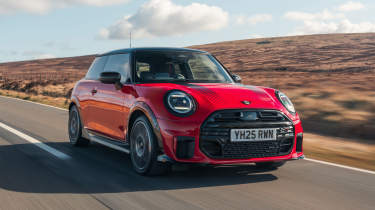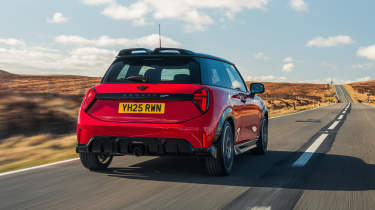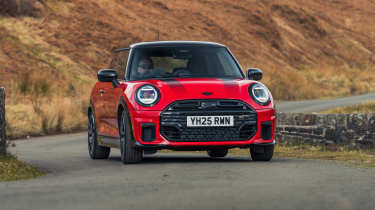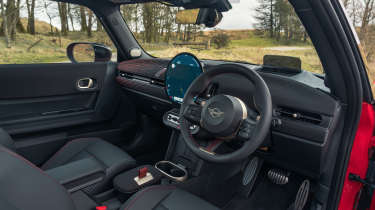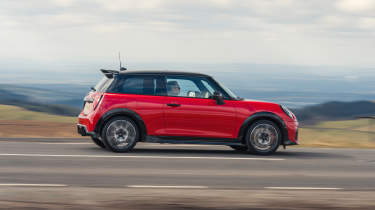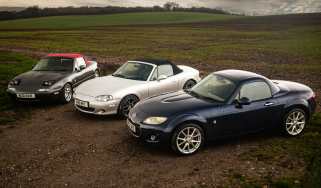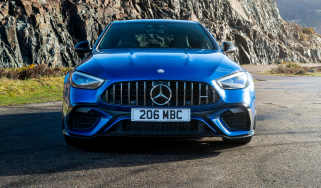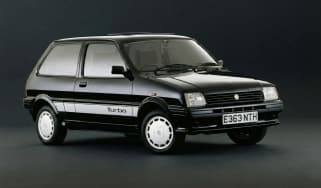Mini JCW 2025 review – too feisty for its own good
The petrol-powered JCW lives on – for now. But in its latest incarnation, has this supermini survivor become too hardcore?
You can’t miss the Mini JCW. Even on a day when there’s a BMW M5, Boxster GTS, Audi RS6 and other big-ticket performance cars in the evo car park, the dinky, Chili Red, racing-striped John Cooper Works holds your attention, staring back at you with its bug-eyed headlights and wide-mouthed expression. It looks chirpy and fun sitting still, and comes with a real sense of anticipation behind it.
That’s because fast superminis on the whole are dying out, and this could be the swansong for hot petrol Minis, with the brand pivoting towards an all-electric line-up in the coming years. Unless there’s a new GP waiting in the wings, we could be looking at the final flourish for fast Minis as we’ve always known them, before focus completely shifts towards the battery-powered Cooper E, Cooper SE and JCW that are currently offered alongside the petrol cars.
Engine, gearbox and technical highlights
- Fresh face hides what is a heavily updated F56 platform
- Relatively light at 1330kg
- 228bhp and 280lb ft from a 2-litre turbo B48 engine
It may look fresh, but this F66-generation car is familiar under the skin. It’s a heavy development of its F56 predecessor rather than an all-new car, and as such rides on BMW’s UKL1 architecture – totally distinct from the EV-specific platform that underpins electric Minis. The JCW’s dampers are fixed, with the raciest Go Kart drive mode ramping up the drivetrain response, adding weight to the steering and slackening off the ESC or disabling it completely if you’ve configured it to do so.
More reviews
Group tests
- Audi A1 Quattro vs Mini JCW GP, Ford Focus RS500 and Renault Megane R26.R
- Mini Coupe JCW v Renault Clio 200 v Corsa VXR Nurburgring v Abarth 695 Tributo
Reviews
- Mini JCW convertible 2025 review – softer JCW adds appeal but also compromises
- Mini JCW 2025 review – too feisty for its own good
- Mini JCW Electric 2025 review – the Alpine A290 has nothing to worry about
- Mini John Cooper Works review - quick and engaging but suffering from middle-aged spread
- Mini John Cooper Works Convertible (F56, 2015 - 2023) review - does losing the roof change the JCW's character?
- Mini John Cooper Works GP (R56, 2013 - 2014) review
- Mini John Cooper Works GP review
As in the previous model, BMW’s B48 turbocharged four-pot engine is stuffed in the JCW’s nose, delivering power via a seven-speed DCT. Peak power is unchanged at 228bhp, but torque has increased significantly from 236lb ft to 280lb ft. This gives a 0-62mph time of 6.1sec – 0.2sec quicker than before – and a 155mph top speed. The electric JCW is even more powerful at 254bhp and a couple of tenths quicker again to 62mph. The petrol car has weight on its side, coming in at 1330kg where the EV has a not-so-mini 1650kg to lug around. The petrol JCW is also £1640 lighter on your wallet at £33,265.
Performance, ride and handling
- Engine and gearbox a little dull
- It's a shame the seven-speed DCT the only transmission option
- Rough ride on most roads can induce headaches
Get moving and there’s a tetchy, hyperactive energy to the JCW, both in its unyielding ride and super-quick steering. It feels switched on and tightly wound from the word go, and though its underlying firmness never goes away, on smooth roads the peppy attitude can be quite fun. The JCW feels four-square and hyper-responsive, and it’s satisfying to feel how keenly the nose hooks into corners with zero slack. The JCW gets a unique suspension tune to deliver this kind of agility and it can live with the immediacy of turn-in, taking up a bit of roll and then digging in hard to find extra bite. This boisterous character slaps you in the face straight away, where other hot hatches give you more layers to peel away and explore.
Odd, then, that the powertrain is comparatively grown-up. The engine and gearbox are effective in shifting the JCW along at a rapid pace but there isn’t the lively, frenetic delivery to match the rest of the car. The B48 is about mid-range muscle rather than living near the red line. Hit the throttle and, once the turbo hits its stride, the wheel starts fighting your hands as the JCW scrambles up the road with real force behind it, the front tyres occasionally lighting up over bumps but finding good drive. Once through that initial surge the top end feels a little flat, so you end up pulling a paddle early, dropping back into the boost and taking off again. You’re not encouraged to wring every drop of power from the engine, instead relying on the torque to pull you from one corner to the next. The gearbox isn’t the most satisfying to use either, with small, clicky paddles and a soft edge to the shifts themselves.
As the surface gets more challenging and you give the JCW a harder workout, it goes from a hyper-energetic hot hatch to a downright frantic one, in a constant fight with you and the road. It has the typical tautness of a modern Mini but dialled up to 11, to the point where you’re jostled around heavily in the seat, almost being thrown out of it on the bumpiest stretches. It’s particularly stiff on the rebound stroke, pulling the body down to retain tight control but never allowing it to flow and work with the surface. Driving the JCW on a particularly bumpy stretch near the evo office had more than one staffer coming back with a headache – it’s that stiff.
It’s a shame that the JCW is so combative, because there is fun to be had and genuinely playful handling to be enjoyed if you find yourself on a well-surfaced road. The super-quick steering is matched to a strong front end, and holding the brakes on the way into corners can swing the rear around in textbook hot hatch style, more easily than in a Cooper S. Time your throttle inputs to catch the boost once the car settles and you slingshot onto the next straight, grinning and fighting a wriggle of torque-steer.
In these moments the JCW is really exciting, but for a lot of the time, it wears you down. The best hot hatches are exploitable in all conditions, but the JCW falls out of its sweet spot and becomes a nuisance on roads where the i20 Ns and Fiesta STs of this world shine. Neither of those are on sale anymore, of course, so it’s particularly sad that this latest JCW is one we can’t hold in such high regard as some of its predecessors.
Driver's note
'The Mini JCW hatch is a baffling car. It's great fun on perfect roads but throw it at an even slightly uneven surface and you genuinely find yourself wondering if Mini took the whole 'go kart feel' thing a bit too far by fitting the JCW with the suspension from one, as you bounce around in the seat, clinging onto the too-thick steering wheel for dear life.' – Ethan Jupp, evo web editor, who drove the Mini JCW hatch on the road in the UK.
Interior and tech
- Interesting interior design
- High quality fit and finish
- UI Submenus can be fiddly to navigate
Inside the JCW and you’re treated to an oddly appealing mix of shapes, materials and design touches that are far more interesting than what you’ll find in a typical supermini. There are classic Mini cues, such as the letterbox view out and the bank of toggle switches on the dash, mixed with new ones such as a fabric-trimmed dash and a reinterpretation of the original Mini’s central speedo, in the form of a large, dish-shaped OLED infotainment screen. Its graphics, response times and feature-set are among the best in class, although we would prefer it if fewer functions, such as the climate controls, were buried within it. It can be tricky to pick your way through some of the fiddly submenus, particularly given how busy the JCW can get on the move (more on which later). We’d also prefer a thinner steering wheel instead of one that only NBA players can grip properly.
Another disappointment is the lack of a stick between the seats. Like the 201bhp Cooper S, the JCW is only offered with a seven-speed DCT, with Mini ditching manuals wholesale for the F66. We’ve just about got over higher-end sports and supercars shifting away from three pedals, but a hot supermini without a manual option is harder to forgive – it’s an integral part of what makes them fun. Unlike the base Cooper S, paddleshifters come as standard to allow manual control of the ’box – a relief, but something that really shouldn’t be worthy of celebration.
Price and rivals
As mentioned, alternatives to the JCW are few and far between, with the £30,740, 204bhp Volkswagen Polo GTI being the only other petrol supermini worth considering in a similar price bracket. Toyota’s GR Yaris sits in an entirely different price category at £46,045, and is also in another world for feel, involvement and capability.
More choice is arriving in the form of battery-powered rivals, however. Alpine’s A290 currently leads that particular group and costs from £33,500, with Abarth offering its 500e for just under £30k, and the bigger, more powerful 600e for £37k.
Naturally, the Mini faces the most competition from the second hand market, where there’s no shortage of bonafide hot hatch icons for similar money. Used FL5 Civic Type Rs can be had for under £35k, while first-gen GR Yaris’s and low mileage Hyundai i20 Ns come in at around £25k. Late Fiesta STs are more affordable still, with lightly used examples sitting in the low £20k bracket.
Mini JCW specs
| Engine | In-line 4-cyl, 1998cc, turbocharged |
|---|---|
| Power | 228bhp @ 5000-6000rpm |
| Torque | 280lb ft @ 1500-4000rpm |
| Weight | 1330kg (174bhp/ton) |
| Tyres | Continental Sport Contact 7 |
| 0-62mph | 6.1sec |
| Top speed | 155mph |
| Basic price | £33,265 |

